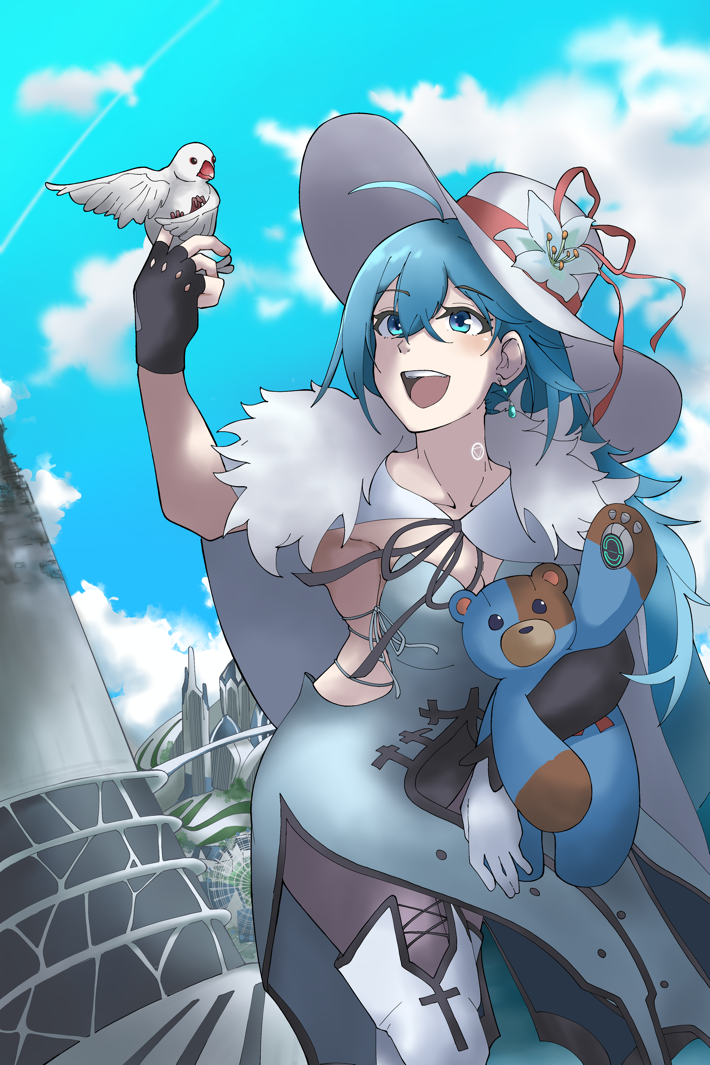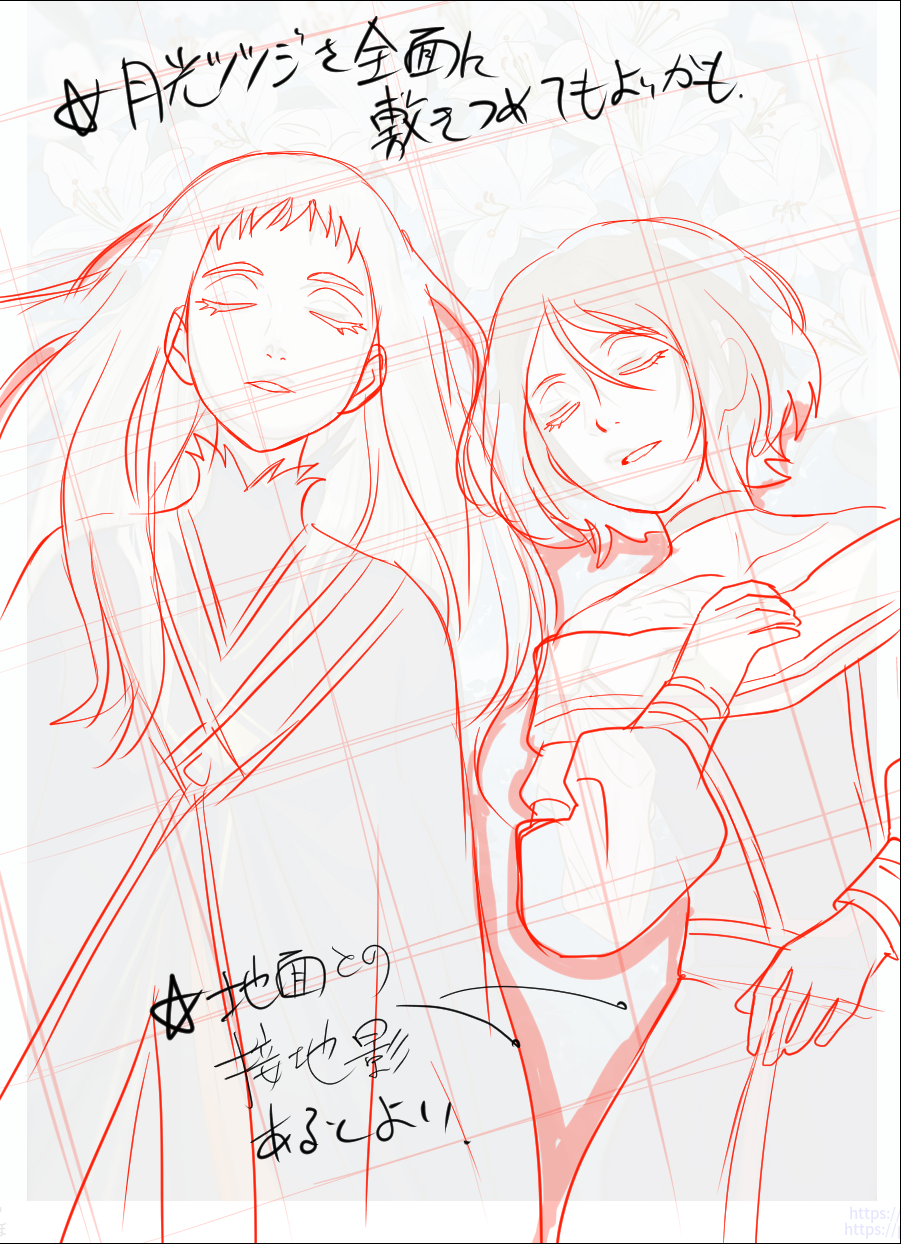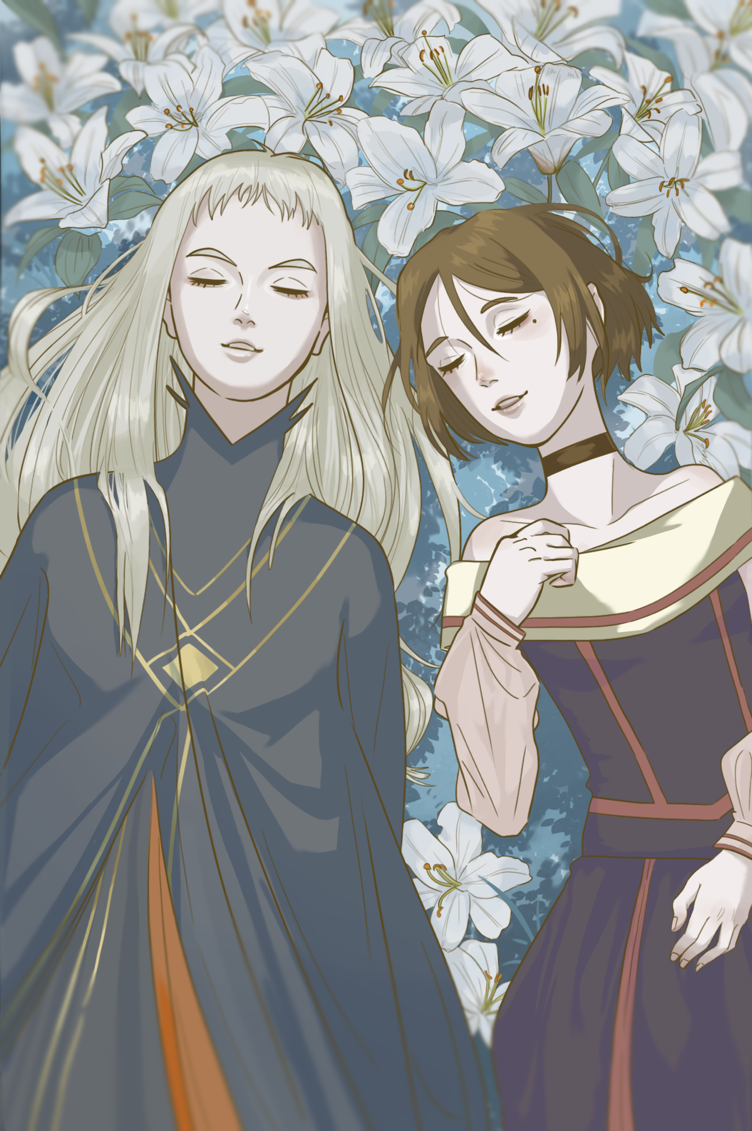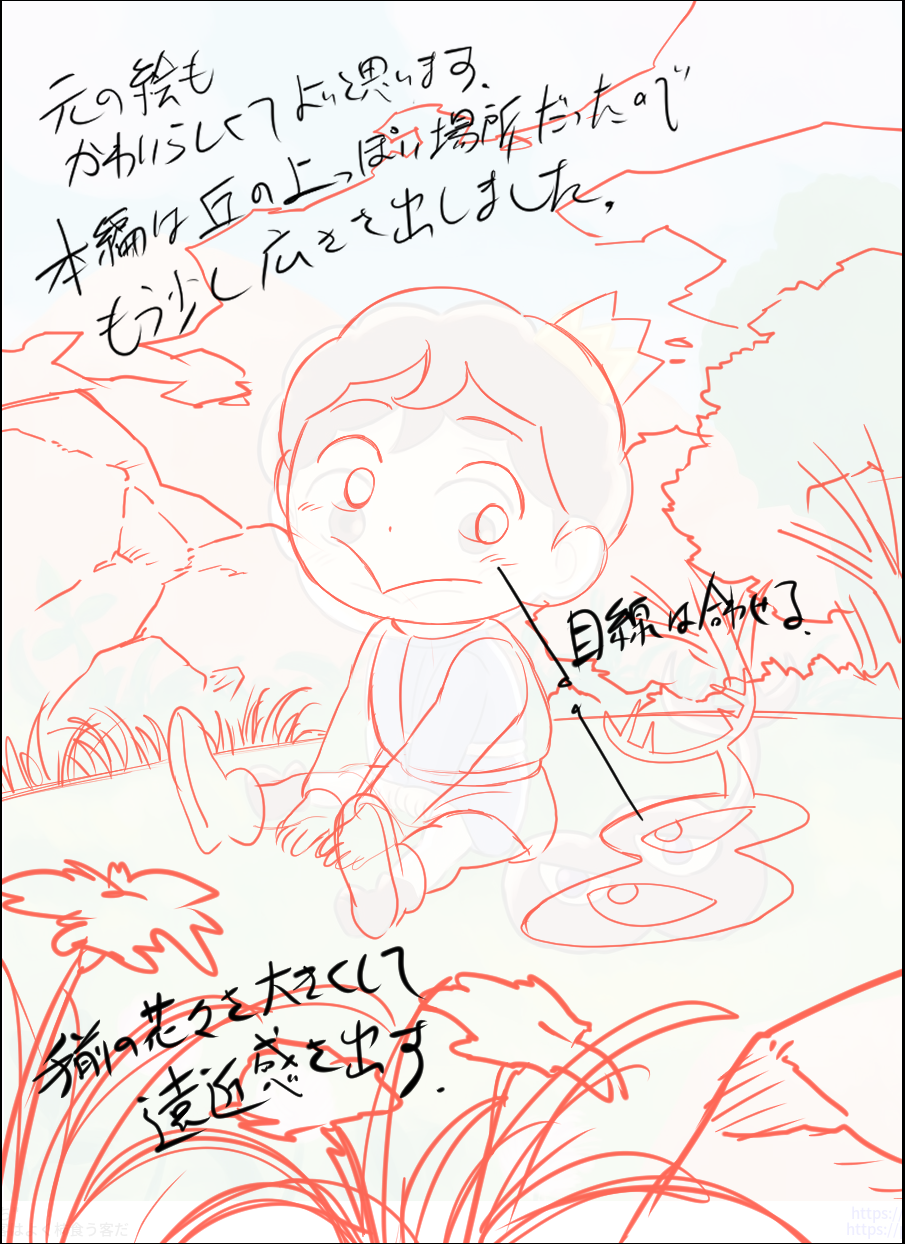「カメラ位置」を意識すれば、絵は変わる!プロのアニメーターが、イラストを添削してみた結果
インタビュー/原田イチボ@HEW
人気アニメ制作会社「WIT STUDIO」が10周年を迎えたのを記念して、同社が制作したアニメをテーマとするイラストコンテストが開催されました。テーマの対象作品となったのは、『Vivy -Fluorite Eye's Song-』、『王様ランキング』、『ヴァンパイア・イン・ザ・ガーデン』、『バブル』、『おにぱん!』。
こちらのコンテストに応募した希望者は、プロのアニメーターから添削を受けることができます。
プロはどういった点を意識して絵を描いているのでしょうか? 同社の取締役にして現役アニメーターである浅野恭司さんに応募作を添削してもらうなかで、いくつかのポイントが見えてきました。
そして、参加してくれたユーザーには、浅野恭司さんの添削をもとに作品をブラッシュアップしていただきました。プロの添削で作品はどう変わるのか、そちらにも注目です!

- 浅野恭司
-
株式会社WITSTUDIO 共同創業者・取締役 キャラクターデザイナー/アニメーター。
株式会社Production I.Gを経て、WIT STUDIOの設立者のひとりに。代表作は「PSYCHO-PASS」(キャラクターデザイン/総作画監督)TVアニメ「進撃の巨人 Season 1-3」(キャラクターデザイン/総作画監督)、TVアニメ「SPY×FAMILY」(総作画監督)など
カメラマンがいるとしたら、どこに立っているか考える
── 今日はよろしくお願いします。これだけのファンアートが集まる機会はなかなか珍しいのではないでしょうか。

そうですね。みなさんの思いが伝わって素直にうれしかったですし、どの作品にもそれぞれの個性があって観るのが楽しかったです。

── こちらに元の作品と、浅野さんによる添削があります。まず野生のゴリラKさんの作品について解説をお願いします。『Vivy -Fluorite Eye's Song-』の主人公・ヴィヴィを描いたイラストですが、「もっとヴィヴィをアップにしてもいいんじゃないか」とアドバイスされていますね。

パッと見たとき、下側の空間が少し寂しく感じました。ヴィヴィと小鳥とマツモトをメインにした作品だと思うので、その3つにもっとわかりやすくスポットライトを当ててもいいんじゃないかな。ただ、女性キャラクターの身体のラインはある程度見せたいですよね。なのでカメラ位置を下げて、少しアオリっぽくしました。元のイラストはヴィヴィの顔あたりにカメラが向いているので、どうしても下半身が俯瞰気味になり、それが下側の寂しさに繋がっているのではないかと。
── なるほど。つい真正面からキャラを描きがちですが、カメラの位置を意識するようになると、絵の描き方が一気に変わりそうですね。

── 野生のゴリラKさんの作品で、「ここは良かった」という点はどこでしょうか?

自分のイメージした通りにしっかり色を塗れている印象なので、そのきちんとした姿勢は大事にしてほしいですね。一方で、もうちょっと「遊び」を取り入れると、より良くなるんじゃないでしょうか。素直に塗るのもひとつの手ですが、あえてコントラストを強めてみるなどのチャレンジをすると、いろんな色味が身につくはずです。
野生のゴリラKさんがブラッシュアップした作品はこちら!

「自分の解釈」をビジュアルで表現するとは?

── では、次はとんぼさんの作品です。『ヴァンパイア・イン・ザ・ガーデン』のモモとフィーネが眠るイラストですね。添削では、ふたりの髪の毛などを調整しています。

初めに見たとき、「これはキャラが地面に寝転がっているのかな? 立っているのかな?」と一瞬迷ってしまいました。なぜ迷ったかというと、地面に落ちたふたりの影がわかりにくいんですよね。あとは髪の毛です。立っているときは髪が重力で足に向かってサラッと落ちるんですが、寝転がると後頭部が押さえつけられ、予期せぬ髪の広がりや曲がり方が出てきます。「ふたりは地面に寝転がっている」というのを明確にするために、影と髪を調整しました。
── ふたりの距離も近づいていますね。

── キャラクターの関係性など、自分なりの意図や解釈をビジュアルに落とし込んでいく作業ですね。

そうですね。自分の添削ではふたりとも目をつぶって穏やかな表情を浮かべていますが、逆にどちらかひとりだけ目を開けさせると、それぞれの気持ちにすれ違いがあるような印象に変わります。「『この点について、自分はこのように解釈している』というのをビジュアルで表現するにはどうしたらいいだろう?」と考えながらイラストを描いています。
── とんぼさんのイラストの良かった点を教えてください。

作品の世界観とも合っていますし、落ち着いた色味が良いですね。ちゃんと資料を見て花を描いていることや、服のシワや影の入れ方をしっかり考えていることも伝わります。そこは長所として、ぜひ伸ばしていってください。
とんぼさんがブラッシュアップ作品はこちら!

奥行きを「遠・中・近」で考える

── 次は青井せのさんによる、『バブル』のウタを描いた作品です。浅野さんの添削ではキャラの頭身が上がっています。

ウタが空中をパルクールで駆けていく姿を見せたいんだと思うので、それなら手足を長く描いたほうが動きが映えます。あとはちょっとした違いですが、つま先を伸ばしてあげるだけで「ジャンプしている最中」というアクションが強調できますよ。
── 青井せのさんは、泡や瓦礫の配置に悩んだそうです。

── 3層に分ける?

── 「遠・中・近」というのも、カメラ位置をめぐる考え方の一環ですね。

どうもお仕事っぽい感じが出ちゃって照れくさいですけどね(笑)。このイラストの場合、カメラマンの役割を果たしているのは、おそらく主人公のヒビキです。きっとヒビキの目線から見たウタを描いているのでしょう。となると、ヒビキとウタのお互いに対する思いというのも景色に乗ってきそうですよね。「ヒビキの目にはウタしか見えていない」という表現として、ウタ以外の物体は思い切って全部ボカシちゃってもおもしろい気がします。
── 青井さんの作品の良かった点を教えてください。

青だけではなく緑や黄色も入れ込んで空の色を塗っていますよね。その発想はとても「わかっているな」と感じました。さらに遊び心を出していくと良いんじゃないでしょうか。
青井せのさんがブラッシュアップ作品はこちら!

「この空間にふたりきり」を明確にするために

── 最後は隣の客はよく柿食う客ださんの、『王様ランキング』のボッジとカゲを描いた作品です。

この作品は添削に迷いました。というのも元の時点で絵柄的に完成されているので、手を加えたらせっかくの持ち味を壊してしまいそうで心配で……。ただ、今回は『王様ランキング』のファンアートということで、アニメスタッフの立場から「こうすると作品の世界観がより表現できるんじゃないか」と提案する形で添削しました。
それでいうとボッジとカゲが出会うのは丘なんですよね。なので丘らしく地面を湾曲させて、その丸みの奥に木々を配置すると良いんじゃないでしょうか。その上で、「この空間にふたりきり」というのを明確にするため、ボッジとカゲの周囲は空けています。あとはさっきも言った「遠・中・近」で、手前の花を強調しました。こうすれば空間がぽっかり空いて寂しく見えてしまうのを避けられますし、のどかな雰囲気も出ると思います。
── 添削後はボッジとカゲの目線が合っていますね。

── 隣の客はよく柿食う客ださんの作品の良かった点を教えてください。

まるで絵本のように温かな世界観を確立していますよね。こういう企画なので添削はしてみましたが、アドバイスに無理に合わせる必要もなくて、隣の客はよく柿食う客ださんのスタイルをそのまま貫き通すのもありなんじゃないかと思っています。

世界はフレームの外にも広がっている
── 浅野さんは若い頃、どんなふうに絵の練習をしていましたか?

クロッキーやデッサン……と言いたいところですが、自分はあまり熱心だったクチではなくて(笑)。ただ、仕事を通してラフをたくさん描いていました。たとえば何かの作品のポスターを描くとするじゃないですか。ラフだけを何枚も何枚も描いていると、収まりの良い構図などがなんとなく理解できてくるんですよ。
どんなポスターにも必ず「作品をどう見せたいか」という意図があり、それがビジュアルに落とし込まれている。いろんな作品のポスターを見るだけでも、ずいぶん勉強になります。だから仕事の中で、参考になりそうなポスターを調べてラフをたくさん描いていたのが、結果的に練習にもなっていたんだと思います。
── 「絵が上手くなりたいなら、イラストだけではなく、写真や映画など実写のものをたくさん見たほうがいい」という言葉をよく聞きます。浅野さんはどうお考えですか?

うーん。「二次元を描くのに二次元のものだけを参考にしちゃダメ」っていうのも、それはそれで発想を狭めているように感じるんですよね。二次元だろうが三次元だろうが、取り入れたもの全部を1枚のイラストに詰め込むってことでいいと思います。
── 発想を狭めてはいけない。

そう。あまり枠にはめて考えないほうがダイナミックなものが描けそうじゃないですか。ああ、でも「自分の肉眼で味わう」ってことは大切かもしれません。どこか高いところに上って街を見下ろすと、すごく広がりを感じます。あの広がりを自分でも表現したいんですけど、どうしても絵である限り、フレームというものが存在するから難しいんですよね。イラストでも写真でも映画でも、作品にはフレームがある。でも世界はフレームの外にも広がっている。そういうことを実感した上で「フレームの内側」を描くと、絵がまた少し変わる気がします。
落ち込んだときは「キター!」と思う
── 将来アニメーターを目指す人たちがやっておいたほうがいいことはありますか?

もちろん絵を描くことは上達に繋がります。経験値を積むと人間は自然と成長していくものなので、「とにかく100枚描いてみる」っていうのは有効だと思いますよ。あと若い子たちに「主観と客観を行き来する能力を身に着けろ」とはよく伝えています。
描いている最中は「俺って上手いなー」と思っていたのに、翌日見たら「なんだこれ……」ってことはよくありますよね。そこで落ち込む必要はなくて、むしろ冷静になったことを大いに利用して、絵をブラッシュアップしていくんです。
── 「なんだこれ……」という感情を逆手に取るんですね。

描いた翌日ではなく1時間後に「なんだこれ」と気づけるようになったら、そのぶんブラッシュアップに早く取りかかれて、制作のスピードも上がりますよね。主観と客観の切り替えをある程度コントロールできるようになると強いと思います。主観/客観の切り替え方は人によっていろいろなので、ちょっと散歩に出るでもいいですし、いったんコーヒーを飲むでもいいですし。なんにせよ自分に合ったやり方をみつけることが大切です。
歳をとったからこそ言えることですが、自分は「なんだこれ。全然ダメじゃん」と感じたときに同時に「キター!」って思うんですよ。欠点が見えたら、あとは直せばいいだけなので。
── 発想の転換ですね……! では創作をしていて落ち込む瞬間はないんでしょうか?

もちろん落ち込む時期はありますが、やっぱりそれなりに長く生きてきたぶん、「下がったなら、そのうち上がるだろう」と多少は余裕がありますね。あと、「若い頃にハマっていたアニメや漫画を見返す」などモチベーションを上げるためのスイッチみたいなものも一応いくつか持っています。
── 特に若い人だと、自分の力不足に落ち込んだりして、楽しく創作できない場面もあるかと思います。そんなときに浅野さんのお話は励みになりそうですね。










